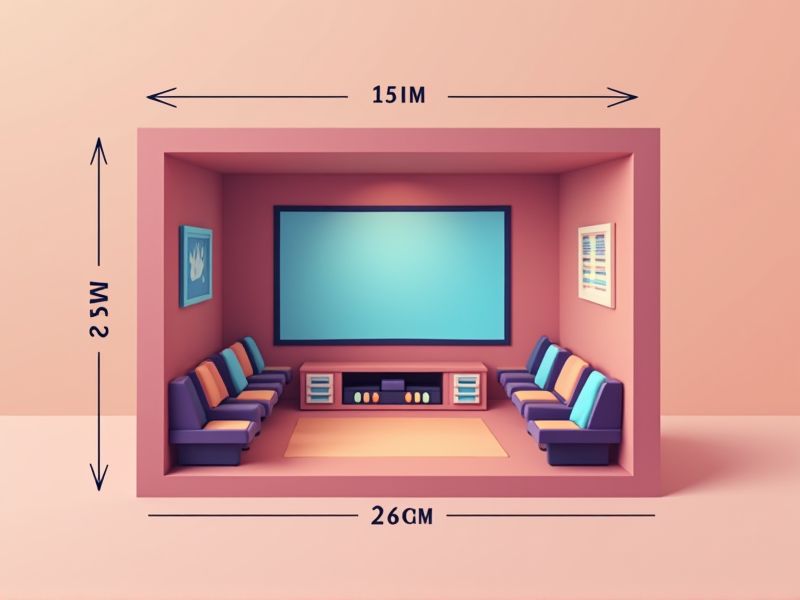
When planning a home theater room, standard dimensions typically range from 12x16 feet to 20x30 feet, depending on your available space and the number of desired seats. A room that is at least 14 feet wide allows for optimal screen size and proper speaker placement. For the best audio experience, it's recommended to avoid rooms with square proportions, as rectangular rooms (such as 12x18 or 15x20 feet) help minimize sound distortions. To further enhance your setup, ensure the ceiling height is at least 8 feet so you have ample space for proper acoustics and comfortable seating arrangements.
Optimal Screen-To-Seating Distance
For an optimal home theater experience, the ideal screen-to-seating distance should be approximately 1.5 to 2.5 times the diagonal size of your display. If you have a 65-inch screen, this translates to a seating distance of 8 to 13 feet. This range ensures that you achieve the best picture quality while maintaining comfort, minimizing eye strain. You should also consider the resolution of your screen; for 4K TVs, sitting closer to the screen can enhance detail perception.
Acoustic Treatment Considerations
Acoustic treatment is vital for creating an optimal home theater experience, involving strategic placement of panels to minimize sound reflections. Consider using bass traps in corners to absorb low frequencies, as they can significantly enhance the clarity of audio at various volume levels. For a space around 200 square feet, aim for at least 20% of wall surfaces covered with acoustic panels to achieve balanced sound quality. You can also incorporate diffusers to scatter remaining sound waves, ensuring that dialogue remains clear while maintaining an immersive atmosphere.
Room Aspect Ratio
The ideal room aspect ratio for a home theater is typically 16:9, which aligns with most modern high-definition televisions and projectors. This ratio helps to minimize visual distortion and enhances the overall viewing experience by providing a balanced frame. For optimum acoustics, aim for a room dimension of about 5 x 7 meters, ensuring enough space for sound waves to travel without interference. A well-designed aspect ratio not only maximizes your viewing pleasure but also elevates the sound quality, immersing you fully in the cinematic experience.
Ceiling Height Specifications
Ceiling height is a crucial specification for optimal home theater performance, typically recommended to be at least 9 to 10 feet to enhance acoustics and overall viewing experience. A higher ceiling allows sound waves to dissipate more effectively, reducing echo and improving audio clarity. For 7.1 surround sound systems, maintaining a minimum ceiling height of 8 feet is essential to accommodate speakers positioned at various elevations. Consider your seating arrangement, as a distance of at least 12 to 18 inches between the top of the screen and the viewer's eye line is ideal for a comfortable viewing angle.
Wall And Floor Material Selection
Choosing the right wall and floor materials is crucial for an optimal home theater experience. Acoustic panels, with options like fabric-wrapped fiberglass or foam, effectively reduce sound reflection and enhance audio quality. For flooring, options such as carpet offer sound absorption, while hardwood or vinyl can provide a sleek finish--just be aware that hard surfaces may require additional soundproofing methods to prevent echo. Your selection should aim for balance between aesthetics and acoustic performance to create an immersive environment.
Speaker Placement Guidelines
Optimal speaker placement is essential for an immersive home theater experience. Position the front left and right speakers at an angle of 22 to 30 degrees from the primary listening position, ideally 3 to 6 feet apart. The center speaker should be placed directly above or below your TV screen for balanced dialogue delivery, while surround speakers are best positioned at ear level, 90 to 110 degrees from your seating area. Ensuring that subwoofers are placed in corners or along walls can enhance bass response, allowing you to enjoy every cinematic detail.
Soundproofing Methods
Effective soundproofing methods for a home theater room include installing acoustic panels, which can reduce sound reverberation significantly by absorbing excess noise. Utilizing soundproof doors and windows can block external noise intrusion, ensuring an immersive audio experience, with high-density insulation materials contributing to overall sound isolation. Sealing gaps around electrical outlets, baseboards, and door frames can decrease sound leakage, enhancing acoustics in your space. Lastly, choosing carpets or thick rugs can further dampen sound, creating a more enjoyable environment for movie nights or gaming sessions.
Lighting Control Options
Effective lighting control is crucial for creating an immersive home theater environment. Incorporating dimmable LED fixtures allows you to adjust brightness levels, enhancing your viewing experience, especially during dark movie scenes. Motorized shades or blackout curtains can eliminate ambient light, which is essential for picture clarity on screens ranging from 75 to 120 inches. By implementing smart lighting systems, you can customize settings and transitions, ensuring the perfect ambiance for movie nights or gaming sessions.
Ventilation And Hvac Considerations
Effective home theater room design prioritizes ventilation and HVAC systems to enhance comfort and audio-visual experience. A well-ventilated room, ideally with an airflow rate of 350-400 cubic feet per minute (CFM), ensures optimal temperature regulation and prevents overheating of equipment. Implementing a dedicated HVAC system designed for spaces typically ranging from 200 to 400 square feet enhances air quality, allowing for noise-control features that minimize sound leakage. For the best performance, consider installing programmable thermostats that adapt to your viewing schedule, maintaining perfect conditions during every cinematic experience.
Seating Arrangement And Comfort
In a home theater room, the seating arrangement is crucial for an optimal viewing experience, with a recommended distance of 1.5 to 2.5 times the screen size to ensure comfort and visual clarity. A configuration featuring reclining chairs or spacious sofas can enhance relaxation, often accommodating 5 to 7 seats for family and friends. Positioning seats at different elevations can improve sightlines, while plush, sound-absorbing materials contribute to a more immersive audio experience. Investing in ergonomic furniture designed for long viewing sessions can significantly increase your overall enjoyment of movies and media.
